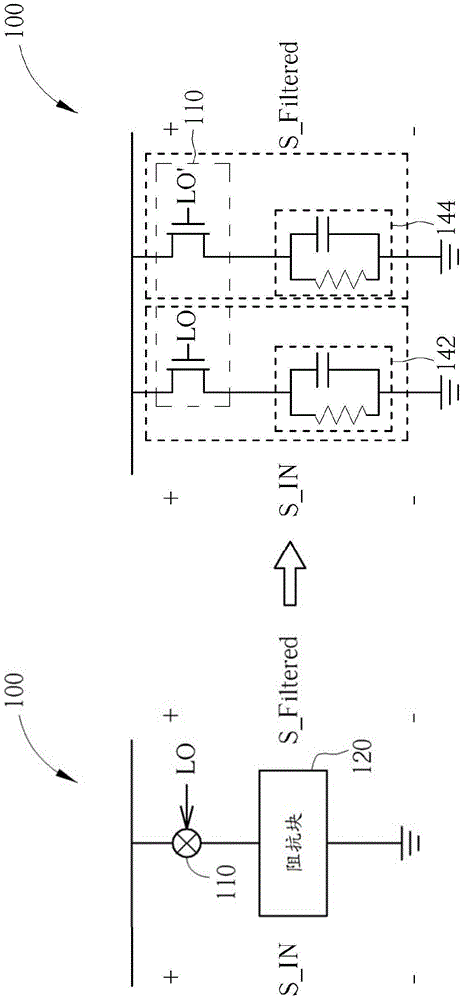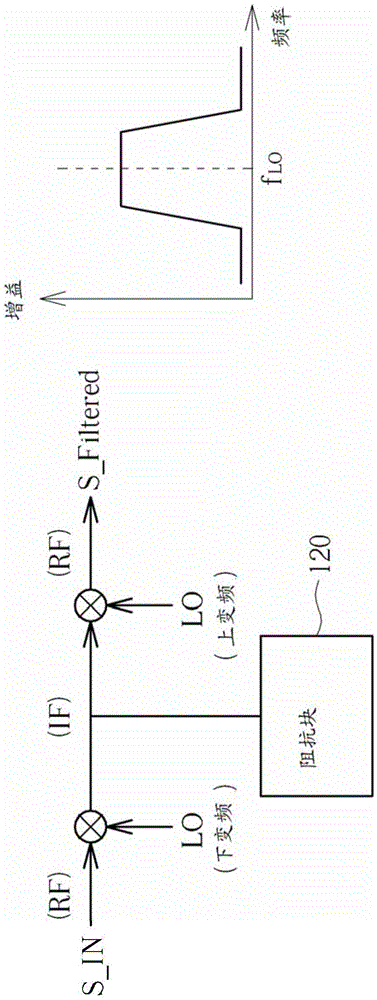Feedforward filter using translational filter
A feed-forward filter and filter technology, applied in the field of feed-forward filters, can solve problems such as difficult to realize low-cost small filters
- Summary
- Abstract
- Description
- Claims
- Application Information
AI Technical Summary
Problems solved by technology
Method used
Image
Examples
Embodiment approach A
[0037] In embodiment A, a feedforward filter with high out-of-band rejection is provided. This feedforward filter consists of a main path and a feedforward path. In-band signals generated by the main path will be preserved, and out-of-band signals or interference will be removed by the feed-forward path. Thus, a bandpass filter with high out-of-band rejection is realized.
[0038] refer to Figure 6A and Figure 6B , Figure 6A and Figure 6B Embodiment A according to the present invention illustrates a block diagram and a detailed implementation of the feedforward filter 300 . Feedforward filter 300 includes a first path 310 and a second path 320 . The input signal S_IN is sent to the first path 310 and the second path 320 . The first path 310 and the second path 320 generate a first output S_F1 and a second output S_F2 respectively. The signal subtractor 330 combines the first output S_F1 and the second output S_F2 to generate a filtered signal S_Filtered.
[0039] ...
Embodiment approach B
[0045] Figure 8 Embodiment B of the present invention is illustrated. In this embodiment, the first path 410 and the second path 420 included in the feedforward filter 400 are respectively driven by local oscillation signals having different frequencies. The first path 410 comprises a first translating filter 412 having a plurality of filter branches, the number of filter branches of the first translating filter 412 depending on the content of the signal S_IN. The filter branch of the first translation filter 412 consists of the same frequency f A and local oscillation signals LOA1 to LOAN of different phases are driven separately. The number of filter branches of the second translation filter 414 is the same as the number of filter branches of the first translation filter 412, but the filter branches of the second translation filter 414 are composed of the same frequency f B and local oscillation signals LOB1 to LOBN of different phases are driven separately. Furthermore...
Embodiment approach C
[0048] Figure 10 The frequency response of the feedforward filter in Embodiment C of the present invention is illustrated. This implementation is similar to Figure 8 The difference between embodiment B and embodiment B is that the outputs of the first path and the second path are combined by using a signal adder instead of a signal subtractor. Therefore, a different equivalent frequency response H can be obtained 430 ’, this frequency response has multiple passbands. If more paths driven by oscillating signals of different frequencies are added to the feedforward filter, more passbands can be created in the frequency response.
[0049] The feedforward filters in embodiments B and C can be used in multi-channel communication systems to receive multiple desired channels at different frequencies and reject all other undesired channels, harmonics, interference and noise. For example, in a TV system, if it is desired to display programs on multiple channels, this filter can b...
PUM
 Login to View More
Login to View More Abstract
Description
Claims
Application Information
 Login to View More
Login to View More - R&D Engineer
- R&D Manager
- IP Professional
- Industry Leading Data Capabilities
- Powerful AI technology
- Patent DNA Extraction
Browse by: Latest US Patents, China's latest patents, Technical Efficacy Thesaurus, Application Domain, Technology Topic, Popular Technical Reports.
© 2024 PatSnap. All rights reserved.Legal|Privacy policy|Modern Slavery Act Transparency Statement|Sitemap|About US| Contact US: help@patsnap.com










